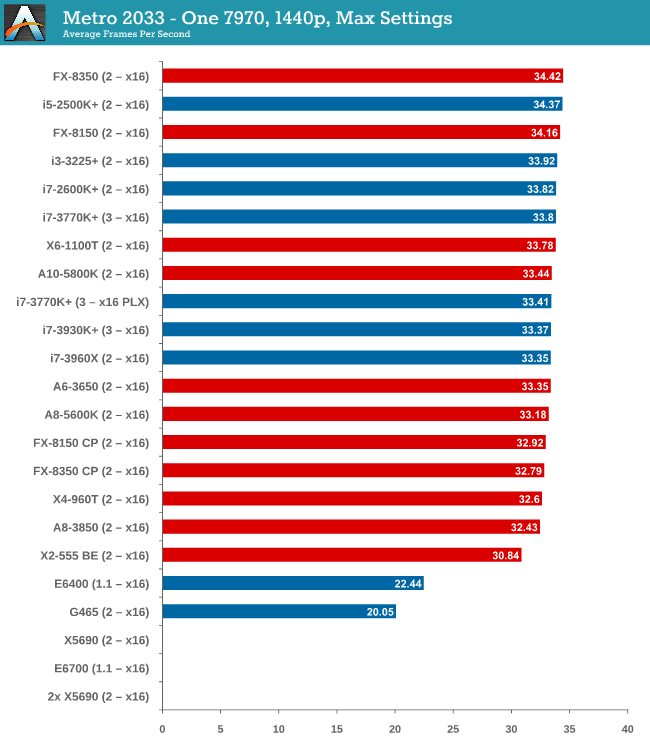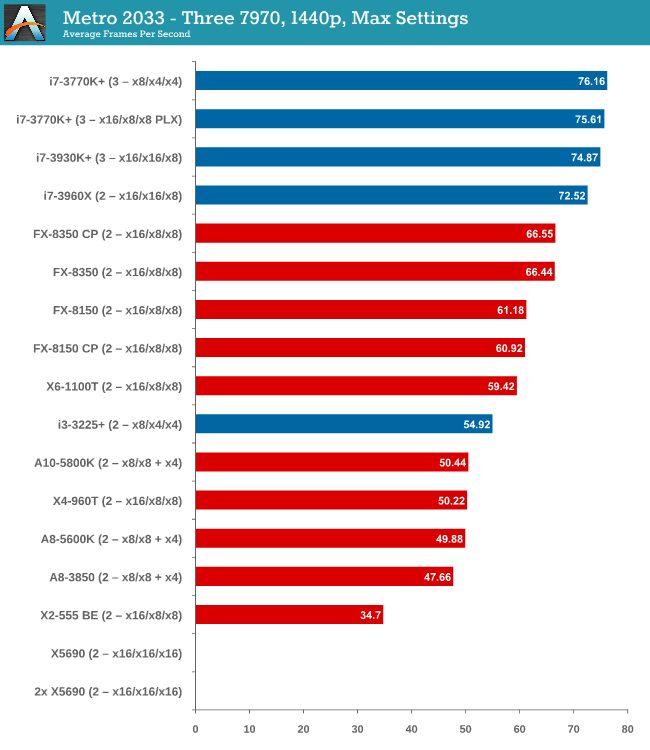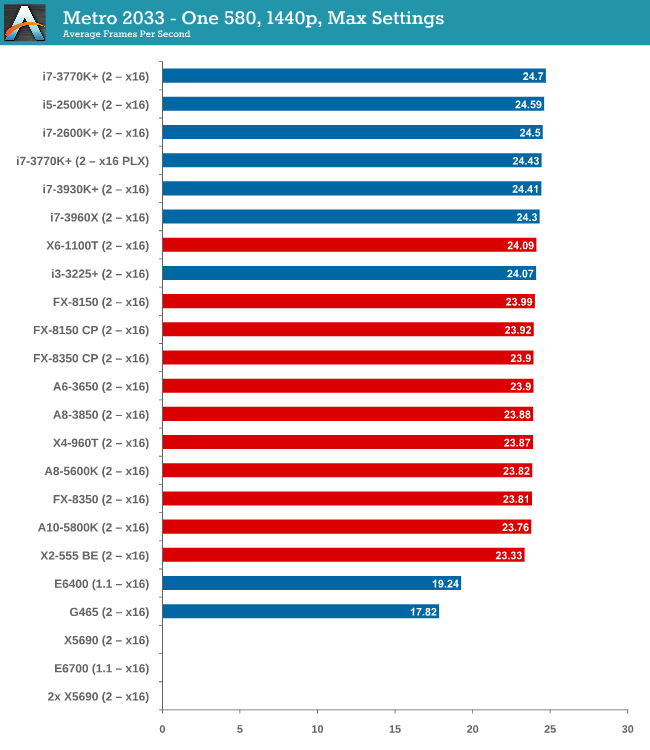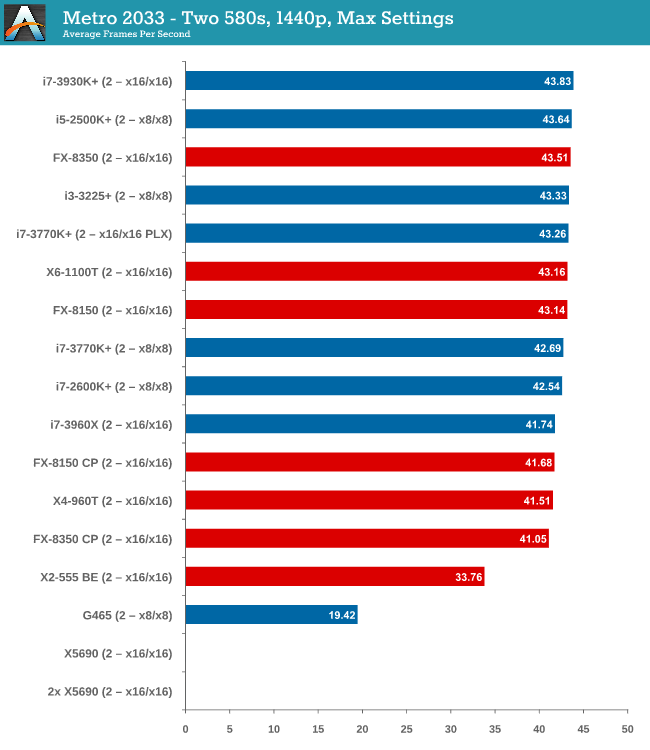Choosing a Gaming CPU: Single + Multi-GPU at 1440p, April 2013
by Ian Cutress on May 8, 2013 10:00 AM ESTMetro 2033
Our first analysis is with the perennial reviewers’ favorite, Metro 2033. It occurs in a lot of reviews for a couple of reasons – it has a very easy to use benchmark GUI that anyone can use, and it is often very GPU limited, at least in single GPU mode. Metro 2033 is a strenuous DX11 benchmark that can challenge most systems that try to run it at any high-end settings. Developed by 4A Games and released in March 2010, we use the inbuilt DirectX 11 Frontline benchmark to test the hardware at 1440p with full graphical settings. Results are given as the average frame rate from a second batch of 4 runs, as Metro has a tendency to inflate the scores for the first batch by up to 5%.
One 7970

With one 7970 at 1440p, every processor is in full x16 allocation and there seems to be no split between any processor with 4 threads or above. Processors with two threads fall behind, but not by much as the X2-555 BE still gets 30 FPS. There seems to be no split between PCIe 3.0 or PCIe 2.0, or with respect to memory.
Two 7970s

When we start using two GPUs in the setup, the Intel processors have an advantage, with those running PCIe 2.0 a few FPS ahead of the FX-8350. Both cores and single thread speed seem to have some effect (i3-3225 is quite low, FX-8350 > X6-1100T).
Three 7970s

More results in favour of Intel processors and PCIe 3.0, the i7-3770K in an x8/x4/x4 surpassing the FX-8350 in an x16/x16/x8 by almost 10 frames per second. There seems to be no advantage to having a Sandy Bridge-E setup over an Ivy Bridge one so far.
Four 7970s

While we have limited results, PCIe 3.0 wins against PCIe 2.0 by 5%.
One 580

From dual core AMD all the way up to the latest Ivy Bridge, results for a single GTX 580 are all roughly the same, indicating a GPU throughput limited scenario.
Two 580s

Similar to one GTX580, we are still GPU limited here.
Metro 2033 conclusion
A few points are readily apparent from Metro 2033 tests – the more powerful the GPU, the more important the CPU choice is, and that CPU choice does not matter until you get to at least three 7970s. In that case, you want a PCIe 3.0 setup more than anything else.










242 Comments
View All Comments
HalloweenJack - Wednesday, May 8, 2013 - link
nice article - would like to have seen an AMD AM2 setup for comparison though. Sadly though I don't like the obvious intel slant - with comments like ` noticeable gap` between intel and amd cpu`s , yet its under 1 fps! I challenge you to actually see a 1fps difference without a meter...IanCutress - Wednesday, May 8, 2013 - link
I didn't say gap with the small 1 FPS differencess, I said split. Whenever I said gap, there is a sizeable difference ~10%. For the small FPS difference in Dirt 3 + one GTX 580, I said "Similar to the one 7970 setup, using one GTX 580 has a split between AMD and Intel that is quite noticeable. Despite the split, all the CPUs perform within 1.3 FPS, meaning no big difference.". Please don't misinterpret my results when I cater for your issue word for word. If you have an issue with a *specific* analysis, please let me know.HalloweenJack - Wednesday, May 8, 2013 - link
again I disagree - you use the words , chosen carefully - the implication is obvious. `gap` and `split` implying a considerable distance between the 2. when in reality there is none. at least anandtech has finally started using real world resolutions and not the pointless 800x600 . poor choice in ambiguous words In writing.HalloweenJack - Wednesday, May 8, 2013 - link
I must ask though - why does civ and total war do poorly on AMD? and will you be adding an AM2 rig - say a 9850?JarredWalton - Wednesday, May 8, 2013 - link
I disagree; "gap" and "split", particularly taken in context, are very clear in the text. What's more, for someone that appears to be worried about a single word choice, you're at the same time ignoring most of the other words.Gap: A break or hole in an object or between two objects.
Split: A tear, crack, or fissure in something, esp. down the middle or along the grain.
There's a split between AMD and Intel, but in many cases not a gap.
ThomasS31 - Wednesday, May 8, 2013 - link
Yes. A Core2Quad would be nice to see.Also some midrange video cards, like HD7870 and GTX660/Ti.
ThomasS31 - Wednesday, May 8, 2013 - link
My point is, that if you are on a budget, but has a C2Quad system... you may not need a new CPU for a new mid-range videocard.Though I admint these are very close to A8-A10 performance, so if that is enough, a C2Q as well might be good.
BTW a very good article... do you planning doing the same for GPUs? :)
IanCutress - Wednesday, May 8, 2013 - link
I have got a Q9400 coming in from a family member for the next update to this review :) Putting more cards in the review might multiply it out too much time wise :/ If there is more requests to try more mid-range cards, I might move to that and retest everything, if I can get the cards in. The 7970s/580s were the only ones I really have to hand to test multi-GPU.Ian
beepboy - Wednesday, May 8, 2013 - link
You're right about the cards, a waste of time - unless its more budget oriented.Pjotr - Wednesday, May 15, 2013 - link
Core2Quad, like my Q9450-ish, I'd only like to know if buying a modern 660 or similar will not hamper that card too much. Not very interested in multi-card configs. Great review you did, but I only looked at the single-card table. I think most people try to balance the single CPU vs GPU upgrade cycles.